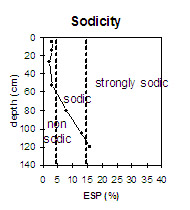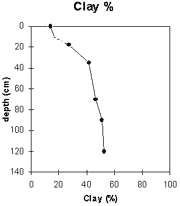NE45
| Property: Rutherglen Research Institute | Paddock #: 32 |
| Aust. Soil Class.: Mottled-Sodic, Eutrophic, Yellow DERMOSOL | Northcote Factual Key: Gn 4.83 |
| Great Soil Group: no suitable group | Map Unit: Stillards loam |
| General Landscape Description: Lower footslope (1% slope) of hill. | |
Soil Profile Morphology:
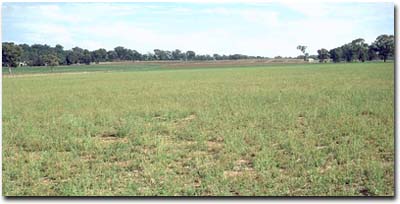
NE45 Landscape
Surface Soil
| A1 | 0-10 cm | Strong brown (7.5YR4/6); fine sandy loam; hardsetting; weakly structured; firm consistence dry; pH 6.5; clear change to: | 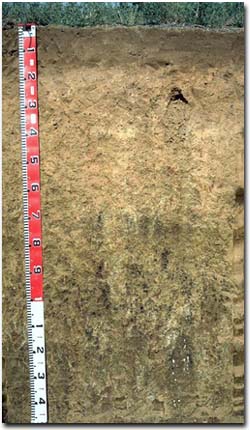 NE45 Profile |
| A2 | 10-18 cm | Strong brown (7.5YR5/6) (7.5YR6/4d); light fine sandy clay loam; contains a common (10%) amount of ferromanganiferous nodules (2-10 mm size); firm consistence dry; pH 5.9; abrupt change to: | |
| Subsoil | |||
| B1 | 18-35 cm | Reddish yellow (7.5YR6/6); fine sandy clay loam, becoming light clay with depth; weakly structured; very firm consistence dry; contains a few (2-5%) ferromanganiferous nodules. pH 6.8; gradual change to: | |
| B21 | 35-70 cm | Brownish yellow (10YR6/8) with dark yellowish brown (10YR3/6) mottles; light medium clay; moderate medium polyhedral, breaking to strong fine polyhedral structure; strong consistence dry; contains some patches of quartz from 50 cm depth; pH 6.8; clear change to: | |
| B22 | 70-90 cm | Yellowish brown (10YR5/8) with yellowish brown (10YR5/6) mottles; medium heavy clay; moderate medium polyhedral, breaking to strong fine polyhedral structure; strong consistence dry; contains a few (5-10%) manganese stains; pH 6.6; gradual change to: | |
| B31 | 90-120 cm | Yellowish brown (10YR5/4) with bright yellowish brown (10YR5/8) mottles; medium heavy clay; moderate very coarse prismatic, breaking to strong medium polyhedral structure; strong consistence dry; contains many (20%) manganese stains and patches of quartz gravel; pH 7.6; gradual change to: | |
| B32 | 120+ cm | Brown (10YR5/3) with yellowish brown (10YR5/6) and strong brown (7.5YR4/6) mottles; medium heavy clay; moderate very coarse prismatic, breaking to strong medium polyhedral structure; strong consistence dry; contains a common (10%) amount of manganese stains; pH 8.5. | |
Key Profile Features:
- Lack of strong texture contrast between surface (A) horizons and subsoil (B21) horizon.
- Significant amount of soft manganese segregations in deeper subsoil.
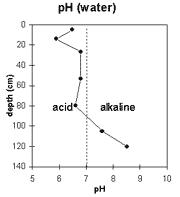 |
| 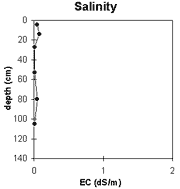 |
|
|
|
|
|
Management Considerations:
Whole Profile
- Plant available water capacity (PAWC) is considered to be low (estimated at 85 mm) for the top metre of the soil profile. This is based on available laboratory data.
- The surface soil has a high fine sand and silt content (76 %). Soil structural stability on such soils depends largely on organic matter to maintain aggregation and prevent slaking. The organic carbon value is low (0.9%) at this pit site. Organic matter levels can be improved by adopting practices such as minimum tillage, stubble retention, pasture rotations and direct drilling.
- The surface soil has a low nutrient status (based on the sum of the exchangeable basic cations). Improving organic matter levels will assist in increasing soil fertility and water holding capacity.
- The relatively low wilting point value (5%) indicates that plants will be able to utilise light rains falling on relatively dry soil.
- The upper subsoil is non-sodic (with a reasonably high exchangeable calcium:magnesium ratio) and is quite well structured (breaking to fine polyhedral shaped peds). As a result, root and water movement will not be significantly restricted. The deeper subsoil is sodic and strongly dispersive and will restrict deeper drainage.
- The upper subsoil has a low-medium nutrient status (based on the sum of the exchangeable basic cations).
- The presence of manganese staining in the deep subsoil may have a toxic effect on deeper rooted manganese sensitive plants.
- Deep ripped (1984), Paraploughed (1990), cultivated five times since 1984.
- Lucerne sowed (1994)
- Lime not used in last 12 years.

